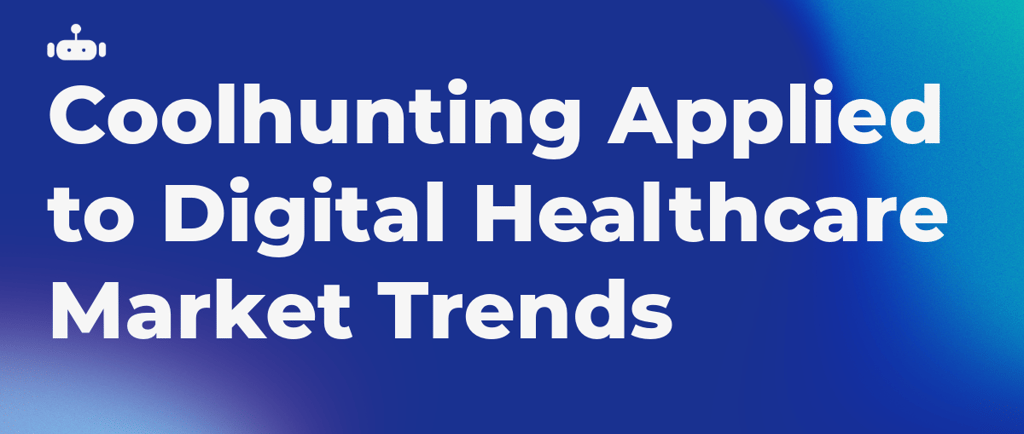Coolhunting Applied to Digital Healthcare Market Trends
Michell Vivas
5/10/20253 min read


Anticipating Innovations
Digital health is advancing rapidly — but adapting is no longer enough: anticipation is key.
This article highlights examples of how coolhunting can be applied to the healthcare sector.
Revenue in the digital health market is projected to reach $197.88 billion by the end of this year, with an estimated annual growth rate (CAGR 2025–2029) of 6.88%, according to Statista data.
In this rapidly transforming environment, coolhunting (early identification of emerging trends) becomes a strategic tool for anticipating market behaviors, guiding innovation, and reducing the risk of obsolescence.
The key question: How can coolhunting be applied in the context of digital healthcare market trends?
Why Is Coolhunting Important in Healthcare?
Traditionally linked to industries like fashion and marketing, coolhunting has evolved into a cross-sector practice. In digital health — where biotechnology, artificial intelligence, big data, and patient experience converge — detecting early signals can create a competitive advantage.
The healthcare market is changing fast:
More than 30% of people worldwide use some type of device to track their health.
In countries like Spain, 55.5% of users have used telemedicine in the past year, compared to 40.6% the year before.
In the first half of 2024, U.S. digital health startups raised $5.7 billion.
In this environment, coolhunting enables companies, investors, and sector leaders to anticipate what’s coming instead of merely reacting.
How to Apply Coolhunting to the Digital Health Market
The identification of emerging signals is a fundamental pillar of coolhunting applied to digital health. These signals are understood as early indications, initial manifestations, or concrete examples of medical procedures, products, aesthetics, or ideas with the potential to scale and become broader trends.
Technologies that are still considered novel today — such as digital therapies based on video games, virtual assistants focused on mental health, or smart implantable devices — already hint at transformations with high future impact potential.
At the same time, cultural and behavioral analysis is crucial to understand evolving user expectations. We are witnessing a shift towards self-care, preventive models, and personalized medicine. New generations, particularly digital natives, increasingly value remote access, instant service, and the ability to actively manage their own health.
These mindset shifts not only influence technology adoption but also redefine success criteria in the patient experience.
Continuous monitoring of the healthcare ecosystem and its players also offers insights into market direction. Observing pharmaceutical industry investments, new healthcare procedures, and startups targeting the sector is critical, as these often seek to solve emerging needs associated with sector growth and new patient demographics.
Additionally, exploring adjacent technologies expands the scope of coolhunting beyond healthcare alone. The convergence of fields — such as generative AI applied to pharmaceutical research or blockchain for medical record management — opens new disruption opportunities that are worth monitoring from their early stages. These intersections often give rise to radical innovations.
Examples:
Digital mental health transitioned from a neglected niche to substantial growth during the pandemic, driven by massive downloads of apps like Calm and Headspace.
Clinical wearables like the Apple Watch have evolved from basic fitness trackers to regulatory-approved cardiac monitoring tools.
These cases show how coolhunting can lead to remarkable transformations in healthcare.
Conclusion
Coolhunting must move beyond being a trend to become a strategic anticipation methodology.
In the context of digital healthcare market trends, it could be the difference between being part of the transformation — or being left behind.
Organizations and healthcare professionals immersed in the digital world who develop a culture of observation, analysis, and early action will be better prepared to adapt to change.
Sources
Digital Health - Worldwide | Statista, 2024
The Role of Wearables and Monitoring Devices in Promoting Healthy Workplace Habits | Vorecol, 2024
H1 2024 Digital Health Funding: Resilience Leads to Brilliance | Rock Health, 2024
How Calm Built a $2B Media, Content Marketing, & YouTube SEO Empire | Foundation Inc.
Coolhunting: What It Is and How to Detect Trends in Business Environments | Universidad Europea, 2023
Contact us
© 2025. All rights reserved. Made with Love by stealthstartup0
